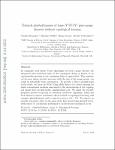Towards glueball masses of large-N SU(N) pure-gauge theories without topological freezing
| dc.contributor.author | Bonanno, C | |
| dc.contributor.author | D'Elia, M | |
| dc.contributor.author | Lucini, B | |
| dc.contributor.author | Vadacchino, D | |
| dc.date.accessioned | 2023-08-15T08:30:51Z | |
| dc.date.available | 2023-08-15T08:30:51Z | |
| dc.date.issued | 2022-10-10 | |
| dc.identifier.issn | 0370-2693 | |
| dc.identifier.issn | 1873-2445 | |
| dc.identifier.other | 137281 | |
| dc.identifier.uri | https://pearl.plymouth.ac.uk/handle/10026.1/21220 | |
| dc.description.abstract |
In commonly used Monte Carlo algorithms for lattice gauge theories the integrated autocorrelation time of the topological charge is known to be exponentially-growing as the continuum limit is approached. This topological freezing, whose severity increases with the size of the gauge group, can result in potentially large systematics. To provide a direct quantification of the latter, we focus on Yang–Mills theory at a lattice spacing for which conventional methods associated to the decorrelation of the topological charge have an unbearable computational cost. We adopt the recently proposed parallel tempering on boundary conditions algorithm, which has been shown to remove systematic effects related to topological freezing, and compute glueball masses with a typical accuracy of . We observe no sizeable systematic effect in the mass of the first lowest-lying glueball states, with respect to calculations performed at nearly-frozen topological sector. | |
| dc.format.extent | 137281-137281 | |
| dc.language | en | |
| dc.publisher | Elsevier BV | |
| dc.subject | Glueball masses | |
| dc.subject | Large-N | |
| dc.subject | Topological freezing | |
| dc.title | Towards glueball masses of large-N SU(N) pure-gauge theories without topological freezing | |
| dc.type | journal-article | |
| dc.type | Article | |
| plymouth.author-url | https://www.webofscience.com/api/gateway?GWVersion=2&SrcApp=PARTNER_APP&SrcAuth=LinksAMR&KeyUT=WOS:000837882700010&DestLinkType=FullRecord&DestApp=ALL_WOS&UsrCustomerID=11bb513d99f797142bcfeffcc58ea008 | |
| plymouth.volume | 833 | |
| plymouth.publication-status | Published | |
| plymouth.journal | Physics Letters B | |
| dc.identifier.doi | 10.1016/j.physletb.2022.137281 | |
| plymouth.organisational-group | |Plymouth | |
| plymouth.organisational-group | |Plymouth|Faculty of Science and Engineering | |
| plymouth.organisational-group | |Plymouth|Faculty of Science and Engineering|School of Engineering, Computing and Mathematics | |
| plymouth.organisational-group | |Plymouth|REF 2021 Researchers by UoA | |
| plymouth.organisational-group | |Plymouth|Users by role | |
| plymouth.organisational-group | |Plymouth|Users by role|Academics | |
| plymouth.organisational-group | |Plymouth|REF 2021 Researchers by UoA|UoA10 Mathematical Sciences | |
| plymouth.organisational-group | |Plymouth|REF 2021 Researchers by UoA|ZZZ Extended UoA 10 - Mathematical Sciences | |
| dcterms.dateAccepted | 2022-06-28 | |
| dc.date.updated | 2023-08-15T08:30:44Z | |
| dc.rights.embargodate | 2023-8-17 | |
| dc.identifier.eissn | 1873-2445 | |
| dc.rights.embargoperiod | forever | |
| rioxxterms.versionofrecord | 10.1016/j.physletb.2022.137281 |


